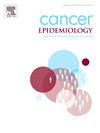右肺癌与左肺癌:来自日本癌症登记数据库的发现
IF 2.3
3区 医学
Q3 ONCOLOGY
引用次数: 0
摘要
侧偏性,即身体左右两侧的生物学差异,已被确定为癌症发生和发展的潜在因素。先前的研究表明,受解剖、遗传和环境因素的影响,左右肺的肺癌发病率可能存在差异。在这项研究中,我们探讨了肺癌的侧边、发病率和预后之间的关系。该队列研究使用了千叶县癌症登记处(2013-2020)的数据,包括36,502例原发性肺癌患者。比较左、右侧肺癌患者的特征。Kaplan-Meier生存曲线、log-rank检验和Cox比例风险模型用于评估死亡率的横向差异,并根据年龄、性别、总分期、组织学类型和其他协变量进行调整。右侧肺癌(60% %)比左侧肺癌(40% %)更为普遍。Cox模型显示右侧肺癌的死亡率略高于左侧肺癌(风险比[HR]: 1.05, 95 %置信区间[CI]: 1.02-1.08, p = 0.003)。性别分层分析显示,男性右侧癌患者的死亡风险较高(HR: 1.08, 95 % CI: 1.04-1.12, p <; 0.001),但女性右侧癌患者的死亡风险无显著差异。右侧肺癌较高的患病率可能与解剖差异和遗传因素有关,如L858R突变的患病率较高。尽管侧边差异的临床影响很小,但这些发现为了解肺癌的发病机制提供了见解,并可能有助于推进个性化医疗。本文章由计算机程序翻译,如有差异,请以英文原文为准。
Right versus left lung cancer: Findings from the Japanese cancer registry database
Laterality, which is the biological difference between the left and right sides of the body, has been identified as a potential factor in cancer development and progression. Previous studies have suggested that lung cancer incidence may differ between the right and left lungs, influenced by anatomical, genetic, and environmental factors. In this study, we investigated the relationship among lung cancer laterality, incidence, and prognosis. This cohort study used data from the Chiba Prefecture Cancer Registry (2013–2020) and included 36,502 patients with primary lung cancer. Patient characteristics were compared between patients with right- and left-sided lung cancers. Kaplan-Meier survival curves, log-rank tests, and Cox proportional hazards models were used to assess laterality differences in mortality, adjusted for age, sex, summary stage, histological type, and other covariates. Right-sided lung cancer was more prevalent (60 %) than left-sided (40 %). The Cox model revealed a slightly higher mortality rate for right-sided lung cancer than for left-sided cancer (hazard ratio [HR]: 1.05, 95 % confidence interval [CI]: 1.02–1.08, p = 0.003). Sex-stratified analysis showed a higher mortality risk for male with right-sided cancer (HR: 1.08, 95 % CI: 1.04–1.12, p < 0.001) but no significant laterality difference in female. The higher prevalence of right-sided lung cancer may be due to anatomical differences and genetic factors, such as the higher prevalence of the L858R mutation. Although the clinical impact of laterality differences is minimal, these findings provide insights into lung cancer pathogenesis and may contribute to advancing personalized medicine.
求助全文
通过发布文献求助,成功后即可免费获取论文全文。
去求助
来源期刊

Cancer Epidemiology
医学-肿瘤学
CiteScore
4.50
自引率
3.80%
发文量
200
审稿时长
39 days
期刊介绍:
Cancer Epidemiology is dedicated to increasing understanding about cancer causes, prevention and control. The scope of the journal embraces all aspects of cancer epidemiology including:
• Descriptive epidemiology
• Studies of risk factors for disease initiation, development and prognosis
• Screening and early detection
• Prevention and control
• Methodological issues
The journal publishes original research articles (full length and short reports), systematic reviews and meta-analyses, editorials, commentaries and letters to the editor commenting on previously published research.
 求助内容:
求助内容: 应助结果提醒方式:
应助结果提醒方式:


